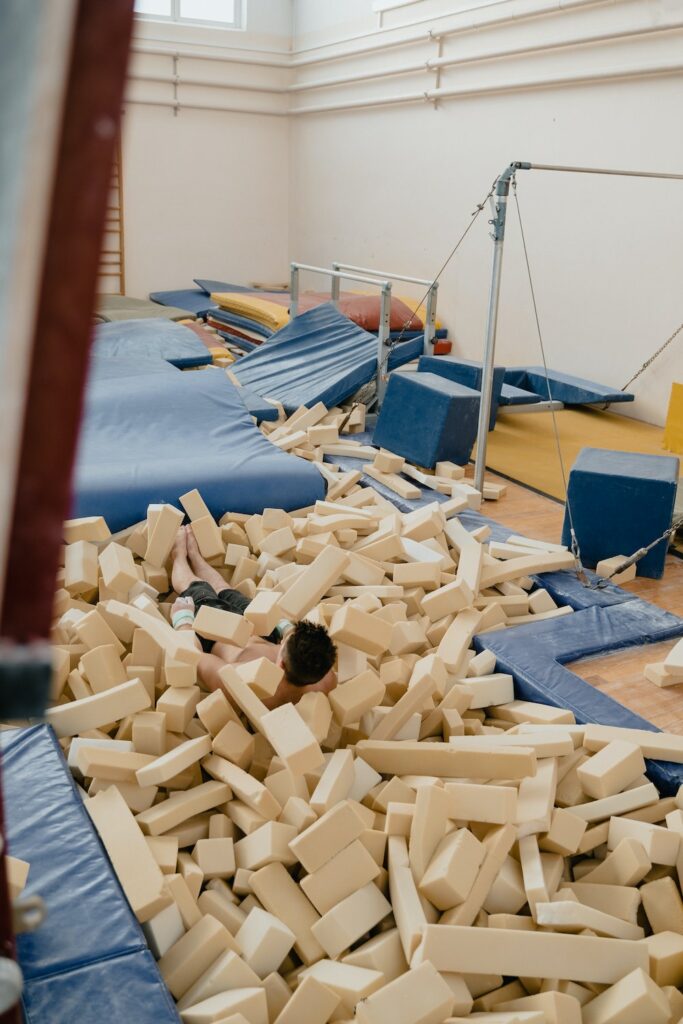GET IN TOUCH
Please contact us for more information. Our email is monitored seven days a week and we will get back to you shortly.

News of two people injured at “Twitch Con” spread on social media after an attendee tweeted that she had broken her back in two places after jumping into a foam pit. A video clip of her jump into the foam pit spread quickly on Twitter and other social media platforms. Unfortunately, injuries in foam pits and other attractions like trampoline parks are becoming increasingly common.
The injuries at Twitch Con occurred at a foam pit sponsored by tech brands Lenovo and Intel. The attraction comprised of two slightly raised platforms over what appeared to be a pit of foam. Participants were meant to stand on the platforms and try to knock one another into the foam. To a casual observer, the activity would seem safe enough. How can a person become injured by falling into a foam pit? However, risks of serious injury are often made worse when participants believe an activity is safer than it really is. In this case, the design of the foam pit attraction was unsafe.
League and Williams has consulted gymnastics experts to understand when foam pit design and operation become dangerous and negligent. In the Lenovo & Intel case, several design and operational factors of the foam pit evidently increased injury risk.

To start, witnesses claimed the foam layer in the Lenovo & Intel foam pit was only about one foot thick. It was made up of one or two layers of foam cubes spread throughout the pit. Typically, foam pits are constructed with several feet of foam blocks (three to four feet at a minimum) for safety.
Second, foam pits are typically constructed over a suspended trampoline like platform. This provides some give to reduce the impact of a fall and reduces the likelihood of injury. In the Lenovo & Intel pit, the small layer of foam obscured the solid concrete floor that was beneath it. Users were unaware of the hard ground they could fall on with no preventative safety measures in place.
Finally, in the Lenovo & Intel foam pit the foam cubes were brand new. New foam cubes have less wear and give than foam cubes that have had some use or have been treated. When someone jumps in, new foam blocks tend to separate rather than compress. This means they will fail to adequately cushion a fall.
The construction of the foam pit likely caused the foam blocks to separate instead of compressing under a falling participant. The pit’s depth and hidden concrete floor led to injuries as participants hit concrete with almost their full body weight.
Often such events require participants to sign a liability waiver. Waivers can impact the ability of a person to recover damages for their injuries. It has been reported that those attending Twitch Con and using the foam pit signed a waiver.
Nathan Grayson, a video games reporter for the Washington Post who attended the event shared details on Twitter. He shared on Twitter that people using the foam pit had to sign a waiver acknowledging risk of injury or damage to personal belongings and a media release for the use of their images. Many people assume that after signing a waiver they are unable to make a claim for any injury sustained. However, not every waiver provides effective defence to operator’s liability, and it is worthwhile to get legal advice on your specific circumstances. The elements of an effective waiver are:
Waivers are very rarely unconscionable or against public policy, so establishing liability where a waiver has been signed usually focuses on ensuring that the criteria #1 has not been met. Most companies are careful to draft their waiver to include details on how almost any injury could occur at their specific attraction in order to protect themselves from liability. For example, it is generally difficult for victims to successfully claim negligence on the part of a trampoline park because they signed a waiver that waived their rights to sue for an accident that is usually precisely outlined in the waiver. Nonetheless, there are several active cases of injured customers at trampoline parks throughout Canada, including the recent case of the Victoria man who died at a trampoline park in Richmond, BC.
Even though a person has signed a waiver acknowledging inherent risk of injury, it is done under a presumption that the vendor has taken reasonable measures to make their attraction safe. In general, waivers will not protect companies from liability where they have breached their duty of care, which includes being diligent in constructing the attraction to be reasonably safe. In order to successfully establish liability when a waiver has been signed, the injured person must prove that the operator failed to warn of the specific danger which resulted in the injury, and/or that the injury was directly caused by the operator’s breach of their duty of care.
Parents signing waivers on behalf of their children should also be aware that they may have further rights and remedies available to them under the B.C. Infant’s Act 1996. For more on this, read our article on minors and liability waivers.
Trampoline park injuries, which include foam pit injuries, are the subject of active litigation around the world. Troublingly, there is no authoritative or government body regulating the safety standards of these facilities in Canada, the U.S. or the U.K. This not only makes it more difficult for lawyers to retrieve damages for their clients, it also makes visits to trampoline parks unnecessarily risky. There are very few established safety requirements for these facilities, and no requirements that staff have basic first aid training, increasing risk of minor or preventable injuries becoming life-changing for victims.
If you are a business assessing liability and drafting a waiver, or have recently been injured after signing a waiver, contact an experienced injury lawyer today. We’ll carefully assess your unique needs and help to protect your interests.
Have a question about this topic or a different legal topic? Contact us for a free consultation. Reach us via phone at 250-888-0002, or via email at info@leaguelaw.com.